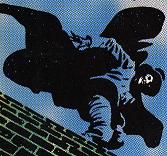Between Bonhoeffer’s Letters and Papers from Prison and The Day After (which my host is currently watching and I’m failing to avoid), I really need to find something cheerier. Maybe some Joy Division.
—About The Day After. Judging from the IMDB message boards, the kids who didn’t grow up with the Cold War think the movie is pretty hokey. I’d agree with that, watching it again with the benefit of 21 years of better special effects and the end of the Soviet Union. But I also remember that I watched it at the age of 10 or 11. And rode the bus to school with the kids from my neighborhood, who were normally a pretty reprehensible bunch of cut-ups (and some actual delinquents), but on that day everyone was absolutely quiet. Kids talked quietly to each other in their seats. My neighbor from across the street, who was known to beat me up from time to time, talked to me and quoted the Einstein saying that appeared in the movie: “I know not with what weapons World War III will be fought, but World War IV will be fought with sticks and stones.” Three years later I was still periodically being jolted awake with dreams that the bombs had fallen.
As for today, I’m grateful we no longer face the spectre of imminent annihilation (though I don’t think the alternative of lots of small scale terrorist attacks is much better). I feel fortunate to have lived through the 90s, during which it seemed for a time, prior to September 11, 2001 anyway, that we could think about war and peace on a human scale again, free of the shadow of the Cold War. I think this is part of what is at the root of my opposition to the restriction of our liberties, the reckless headlong plunge toward war in the Middle East, the growing cloud of suspicion (which has gotten so bad that a dark-skinned photography student can be singled out as a possible terrorist for taking photos of one of Seattle’s most notable tourist attractions) of our fellow man: that I have tasted freedom from fear in my lifetime and do not want to surrender to fear once more.
Here Bonhoeffer points the way, in his essay “After Ten Years,” written in 1943 during his imprisonment. Two things he wrote in this essay, after being denied the freedom to publish, to preach, to teach, and ultimately to leave his cell, stick with me in some quiet way:
Surely there has never been a generation in the course of human history with so little ground under its feet as our own. Every conceivable alternative seems equally intolerable. We try to escape from the present by looking entirely to the past or the future for our inspiration, and yet, without indulging in fanciful dreams, we are able to wait for the success of our cause in quietness and confidence. It may be however that the responsible, thinking people of earlier generations who stood at a turning-point of history felt just as we do, for the very reason that something new was being born which was not discernible in the alternatives of the present. …
Optimism: It is more prudent to be a pessimist. It is an insurance against disappointment, and no one can say “I told you so,” which is how the prudent condemns the optimist. The essence of optimism is that it takes no account of the present, but it is a source of inspiration, of vitality and hope where others have resigned; it enables a man to hold his head high, to claim the future for himself and not to abandon it to his enemy. Of course there is a foolish, cowardly kind of optimism which is rightly condemned. But the optimism which is will for the future should never be despised, even if it is proved wrong a hundred times. … To-morrow may be the day of judgment. If it is, we shall gladly give up working for a better future, but not before.




